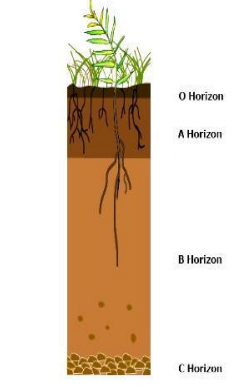The material that covers the earth’s surface, known as soil, is created as a result of rock weathering. At its core are soil minerals. They are created from rocks (the parent material) by weathering and erosive forces of nature. Parent material is broken down with the assistance of water, wind, gravity, temperature variation, chemical reactions, living things, and pressure variations.
SOIL PROFILE:
Layers (or horizons) that build a soil profile as it ages are called horizons. Topsoil and subsoil are the two main layers that make up the majority of soil profiles. As you descend the soil profile, layers of soil are called soil horizons. There may be easy-to-dig or difficult-to-dig soil horizons in a soil profile distinguish.
Typically, soils have three primary horizons:
A horizon of nutrient-rich topsoil with high levels of organic matter, biological activity, and the majority of plant roots, earthworms, insects, and microorganisms. Because of the organic compounds, the A horizon is typically darker than other horizons.
Clay-rich subsoil is in the B horizon. While holding more moisture than the topsoil, this horizon is frequently less fruitful. Compared to the A horizon, it often has a lighter tint and less biological activity. The texture can also be more dense than the A horizon.
Underlying weathered rock, from which the A and B horizons are formed, is the C horizon. Some soils also have an O horizon mainly consisting of plant litter which has accumulated on the soil surface.The properties of horizons are used to distinguish between soils and determine land-use potential.

FORMATION OF SOIL:
A significant section of the Earth’s crust is covered by soil, which is an unaggregated or uncemented deposit of mineral and/or biological components or pieces. Few microns in diameter to enormous boulders in size make up the gamut of particle sizes. It contains sand, gravel, clay, silt, and other materials.
The geologic cycle, which includes weathering, movement, deposition, and then more weathering, results in the development of soil.
Agencies like regular temperature variations, the impact and splitting action of flowing water, ice, and wind, plants, and animals all contribute to physical weathering.
For instance: – Sand and other cohesion-less soils.
Oxidation, hydration, carbonation, desilication leaching by organic acids, and water all contribute to chemical weathering.
- Rocks regularly experience oxidation. It works similarly to how steel rusts when it comes into touch with damp air.
- Carbonation: Carbonic acid, which is created when carbon dioxide and water combine to generate carbon dioxide, can break down minerals that contain iron, calcium, magnesium, sodium, or potassium.
- Hydration: This widespread phase of rock deterioration involves mixing rock with various soil constituents to create new minerals. Humid regions require you to hydrate more quickly than arid ones do.
- Desilication: This technique involves leaching away dissolved or colloidal silica that has been liberated during another chemical reaction.
- Leaching: Leaching is the process by which water-soluble components (Calcium Carbonate) are broken down and removed from the soil by irrigation, subsurface flow, rainfall, or other fluids.
Soil obtained due to weathering are off 2 types namely transported and residual:
These soils continue to cover the parent Rock as residual soils. They are primarily discovered at shallow depths.
Soils that have been picked up, mixed, dissolved, transported, and then redeposited fall under the category of transported soils. They are located at great depths. Depending on how they are transported and deposited, they may be homogenous or heterogeneous, or they may change in particle size, shape, and texture.
Transported soils can be classified further into:
- Soils carried by rivers and streams are referred to as alluvial soils. Sedimentary clay, for instance.
- Aeoline soils are those that are carried by the wind. Instance: Loess
- soil carried by glaciers is referred to as glacial soil. Illustration: Glacial Fill
- Soils deposited in lakes and beds are called locustrine soils. For instance, locustrine clays
- Marine soils are those that have been dumped in the ocean. For instance, marine clays and silts
